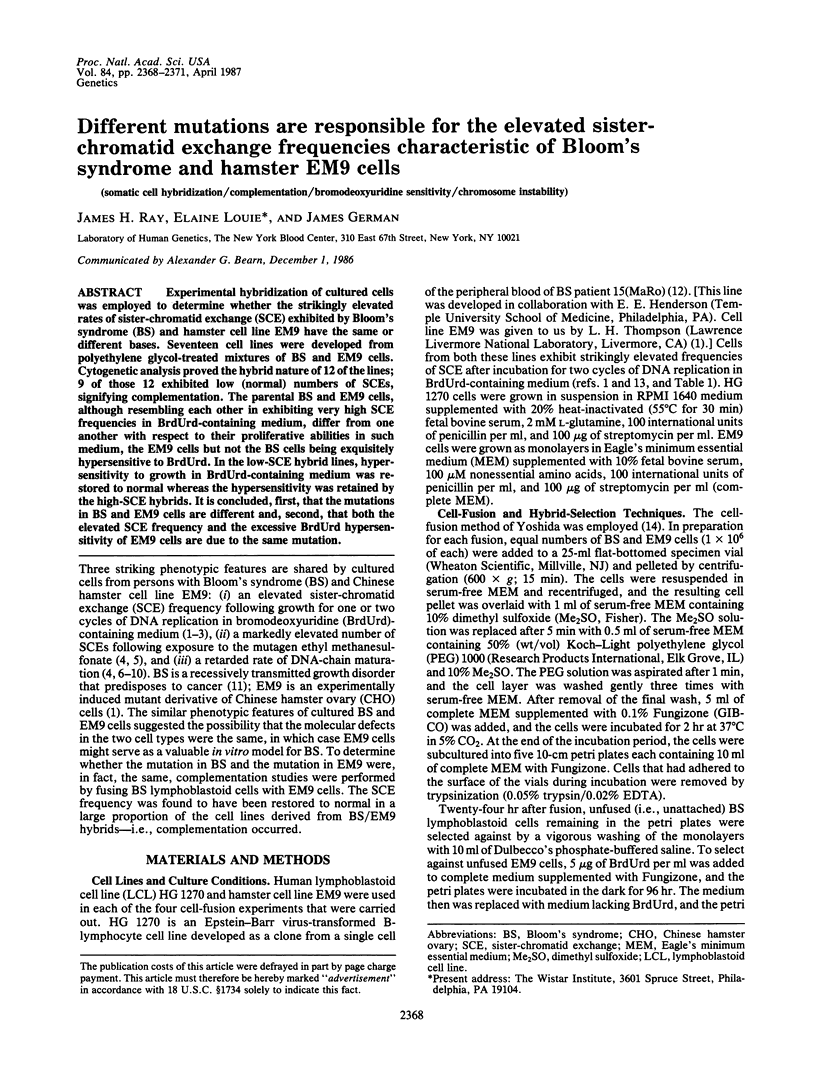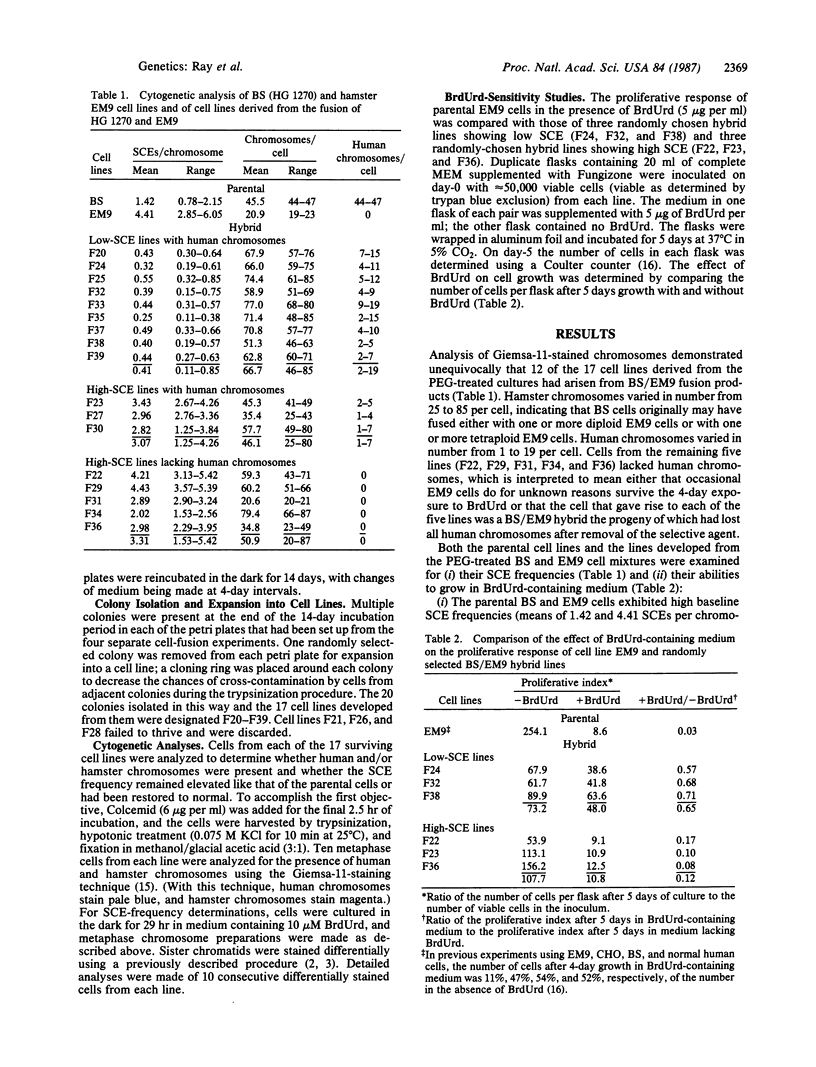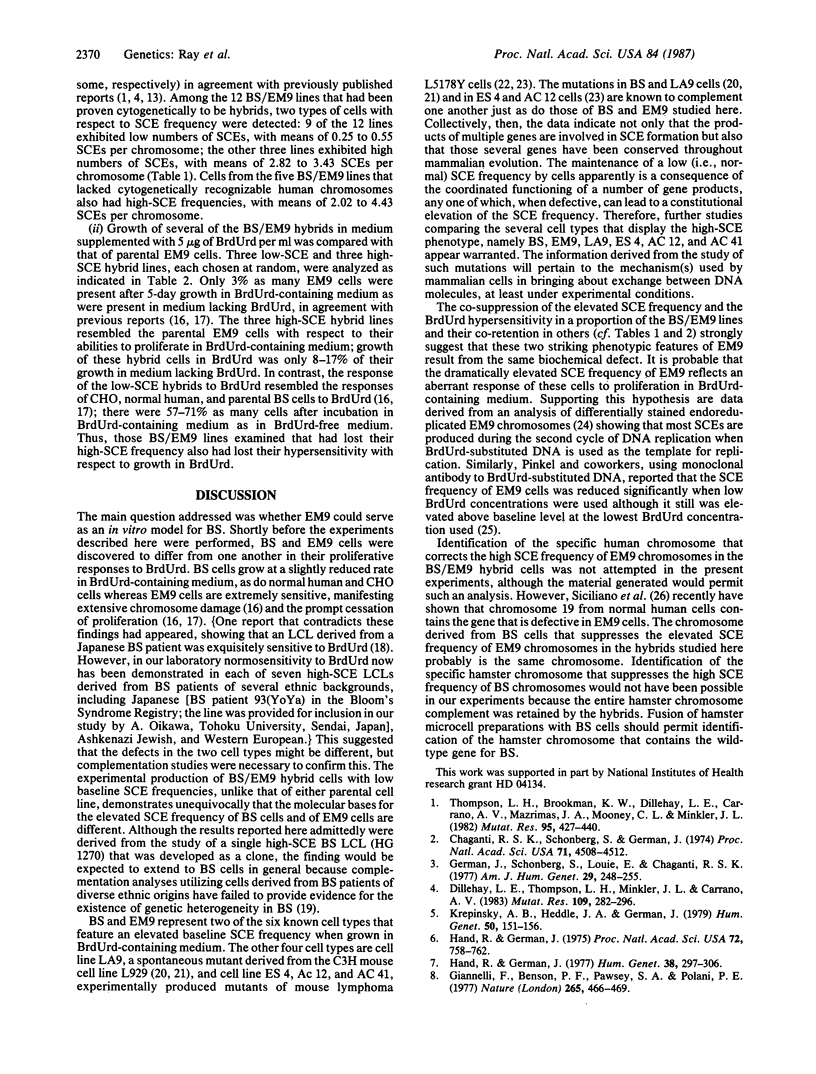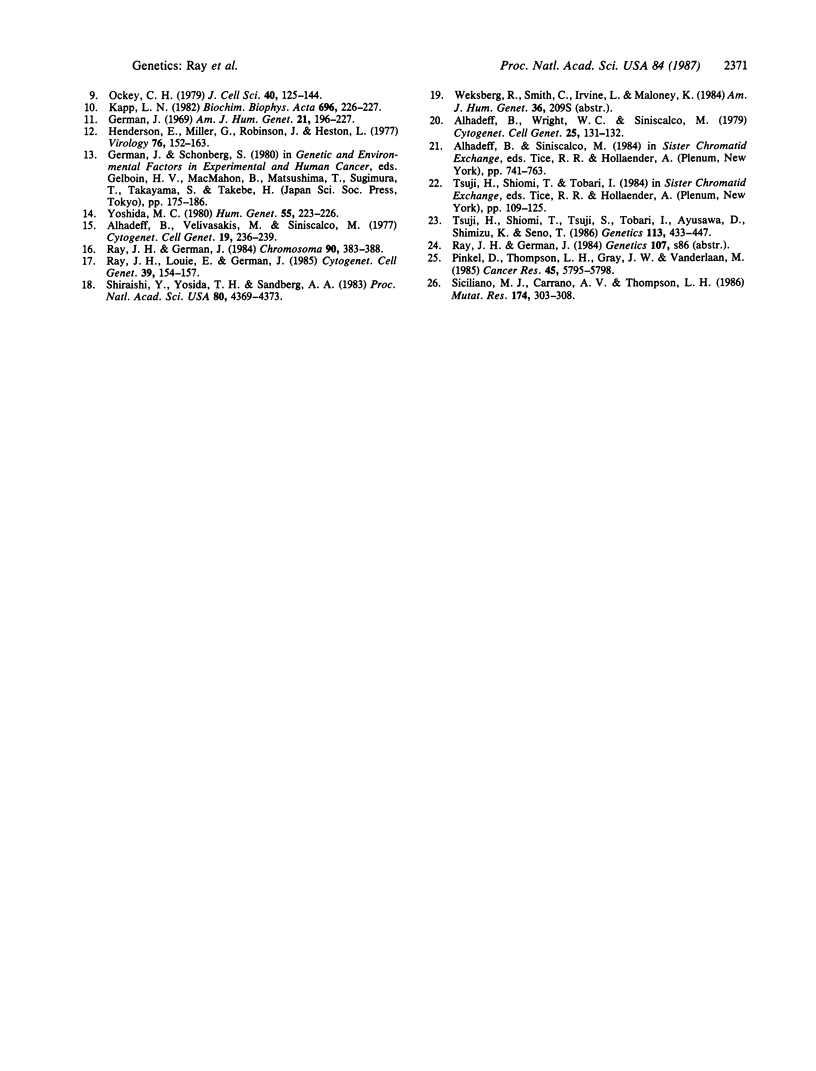Abstract
Experimental hybridization of cultured cells was employed to determine whether the strikingly elevated rates of sister-chromatid exchange (SCE) exhibited by Bloom's syndrome (BS) and hamster cell line EM9 have the same or different bases. Seventeen cell lines were developed from polyethylene glycol-treated mixtures of BS and EM9 cells. Cytogenetic analysis proved the hybrid nature of 12 of the lines; 9 of those 12 exhibited low (normal) numbers of SCEs, signifying complementation. The parental BS and EM9 cells, although resembling each other in exhibiting very high SCE frequencies in BrdUrd-containing medium, differ from one another with respect to their proliferative abilities in such medium, the EM9 cells but not the BS cells being exquisitely hypersensitive to BrdUrd. In the low-SCE hybrid lines, hypersensitivity to growth in BrdUrd-containing medium was restored to normal whereas the hypersensitivity was retained by the high-SCE hybrids. It is concluded, first, that the mutations in BS and EM9 cells are different and, second, that both the elevated SCE frequency and the excessive BrdUrd hypersensitivity of EM9 cells are due to the same mutation.
Full text
PDF



Selected References
These references are in PubMed. This may not be the complete list of references from this article.
- Abstracts of meeting presentations. Cytogenet Cell Genet. 1979;25(1-4):131–221. [PubMed] [Google Scholar]
- Alhadeff B., Velivasakis M., Siniscalco M. Simultaneous identification of chromatid replication and of human chromosomes in metaphases of man-mouse somatic cell hybrids. (With 1 color plate). Cytogenet Cell Genet. 1977;19(4):236–239. doi: 10.1159/000130814. [DOI] [PubMed] [Google Scholar]
- Chaganti R. S., Schonberg S., German J. A manyfold increase in sister chromatid exchanges in Bloom's syndrome lymphocytes. Proc Natl Acad Sci U S A. 1974 Nov;71(11):4508–4512. doi: 10.1073/pnas.71.11.4508. [DOI] [PMC free article] [PubMed] [Google Scholar]
- Dillehay L. E., Thompson L. H., Minkler J. L., Carrano A. V. The relationship between sister-chromatid exchange and perturbations in DNA replication in mutant EM9 and normal CHO cells. Mutat Res. 1983 May;109(2):283–296. doi: 10.1016/0027-5107(83)90053-2. [DOI] [PubMed] [Google Scholar]
- German J. Bloom's syndrome. I. Genetical and clinical observations in the first twenty-seven patients. Am J Hum Genet. 1969 Mar;21(2):196–227. [PMC free article] [PubMed] [Google Scholar]
- German J., Schonberg S., Louie E., Chaganti R. S. Bloom's syndrome. IV. Sister-chromatid exchanges in lymphocytes. Am J Hum Genet. 1977 May;29(3):248–255. [PMC free article] [PubMed] [Google Scholar]
- Gianneli F., Benson P. F., Pawsey S. A., Polani P. E. Ultraviolet light sensitivity and delayed DNA-chain maturation in Bloom's syndrome fibroblasts. Nature. 1977 Feb 3;265(5593):466–469. doi: 10.1038/265466a0. [DOI] [PubMed] [Google Scholar]
- Hand R., German J. A retarded rate of DNA chain growth in Bloom's syndrome. Proc Natl Acad Sci U S A. 1975 Feb;72(2):758–762. doi: 10.1073/pnas.72.2.758. [DOI] [PMC free article] [PubMed] [Google Scholar]
- Hand R., German J. Bloom's syndrome: DNA replication in cultured fibroblasts and lymphocytes. Hum Genet. 1977 Oct 14;38(3):297–306. doi: 10.1007/BF00402156. [DOI] [PubMed] [Google Scholar]
- Henderson E., Miller G., Robinson J., Heston L. Efficiency of transformation of lymphocytes by Epstein-Barr virus. Virology. 1977 Jan;76(1):152–163. doi: 10.1016/0042-6822(77)90292-6. [DOI] [PubMed] [Google Scholar]
- Kapp L. N. DNA fork displacement rates in Bloom's syndrome fibroblasts. Biochim Biophys Acta. 1982 Feb 26;696(2):226–227. doi: 10.1016/0167-4781(82)90034-3. [DOI] [PubMed] [Google Scholar]
- Krepinsky A. B., Heddle J. A., German J. Sensitivity of Bloom's syndrome lymphocytes to ethyl methanesulfonate. Hum Genet. 1979;50(2):151–156. doi: 10.1007/BF00390236. [DOI] [PubMed] [Google Scholar]
- Ockey C. H. Quantitative replicon analysis of DNA synthesis in cancer-prone conditions and the defects in Bloom's syndrome. J Cell Sci. 1979 Dec;40:125–144. doi: 10.1242/jcs.40.1.125. [DOI] [PubMed] [Google Scholar]
- Pinkel D., Thompson L. H., Gray J. W., Vanderlaan M. Measurement of sister chromatid exchanges at very low bromodeoxyuridine substitution levels using a monoclonal antibody in Chinese hamster ovary cells. Cancer Res. 1985 Nov;45(11 Pt 2):5795–5798. [PubMed] [Google Scholar]
- Ray J. H., German J. Bloom's syndrome and EM9 cells in BrdU-containing medium exhibit similarly elevated frequencies of sister chromatid exchange but dissimilar amounts of cellular proliferation and chromosome disruption. Chromosoma. 1984;90(5):383–388. doi: 10.1007/BF00294165. [DOI] [PubMed] [Google Scholar]
- Ray J. H., Louie E., German J. Hybridization with human cells corrects the elevated SCE frequency and BrdU hypersensitivity of hamster cell line EM9. Cytogenet Cell Genet. 1985;39(2):154–157. doi: 10.1159/000132126. [DOI] [PubMed] [Google Scholar]
- Shiraishi Y., Yosida T. H., Sandberg A. A. Analyses of bromodeoxyuridine-associated sister chromatid exchanges (SCEs) in Bloom syndrome based on cell fusion: single and twin SCEs in endoreduplication. Proc Natl Acad Sci U S A. 1983 Jul;80(14):4369–4373. doi: 10.1073/pnas.80.14.4369. [DOI] [PMC free article] [PubMed] [Google Scholar]
- Siciliano M. J., Carrano A. V., Thompson L. H. Assignment of a human DNA-repair gene associated with sister-chromatid exchange to chromosome 19. Mutat Res. 1986 Aug;174(4):303–308. doi: 10.1016/0165-7992(86)90051-5. [DOI] [PubMed] [Google Scholar]
- Thompson L. H., Brookman K. W., Dillehay L. E., Carrano A. V., Mazrimas J. A., Mooney C. L., Minkler J. L. A CHO-cell strain having hypersensitivity to mutagens, a defect in DNA strand-break repair, and an extraordinary baseline frequency of sister-chromatid exchange. Mutat Res. 1982 Aug;95(2-3):427–440. doi: 10.1016/0027-5107(82)90276-7. [DOI] [PubMed] [Google Scholar]
- Tsuji H., Shiomi T., Tsuji S., Tobari I., Ayusawa D., Shimizu K., Seno T. Aphidicolin-resistant mutants of mouse lymphoma L5178Y cells with a high incidence of spontaneous sister chromatid exchanges. Genetics. 1986 Jun;113(2):433–447. doi: 10.1093/genetics/113.2.433. [DOI] [PMC free article] [PubMed] [Google Scholar]
- Yoshida M. C. Suppression of spontaneous and mitomycin C-induced chromosome aberrations in Fanconi's anemia by cell fusion with normal human fibroblasts. Hum Genet. 1980;55(2):223–226. doi: 10.1007/BF00291770. [DOI] [PubMed] [Google Scholar]


